William Powhida‘s magic derives from a simple premise: If he makes fun of you, other people will laugh. (It’s art world teeter-totter. Your stock goes down, his rises.) Seattle has its own version. Instead of a smart-aleck upstart, Seattle has an old grump. When the old grump (critic Matthew Kangas) visited Powhida and Eric Trosko‘s exhibit at Platform Gallery, Magicality, dealer Stephen Lyons visibly braced himself.
Kangas started with what appeared to be a compliment, congratulating Lyons for packing the space. As Kangas is aware, that praise needs to go to the curators. Left to his own devices, Lyons favors spare. Kangas was born too late for salon style but does his best to revive it. Moving into the back room, he looked down on a group of Jaq Chartier’s small paintings lying on top of a table. “Are these trivets?” he asked.
Chartier 7 Stain Lines
2009, 6 x 6 inches
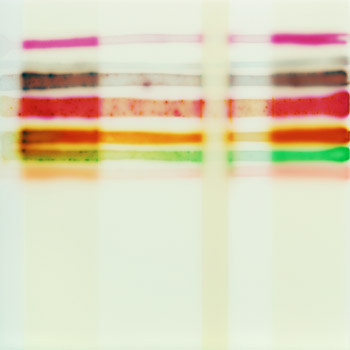 Lyons was not amused, but as Powhida’s Seattle dealer, he chuckled over the drawing reproduced below, a visual rant on the abilities of painter Dana Schutz. Powhida followed with a hex on her dealer, Zach Feuer, who took neither sally lying down. (Powhida told Jen Graves it was “like hooking a shark.” )
Lyons was not amused, but as Powhida’s Seattle dealer, he chuckled over the drawing reproduced below, a visual rant on the abilities of painter Dana Schutz. Powhida followed with a hex on her dealer, Zach Feuer, who took neither sally lying down. (Powhida told Jen Graves it was “like hooking a shark.” )
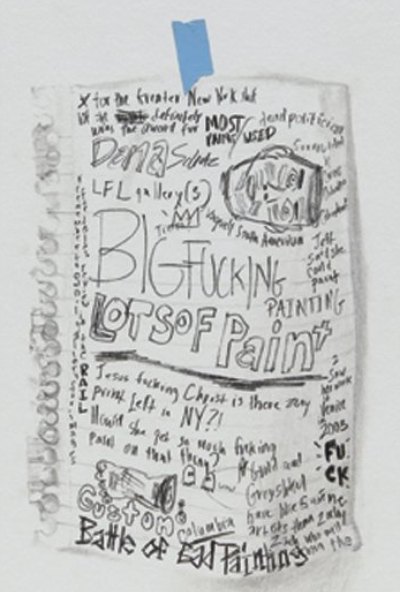 Powhida takes pains to point out that he is not William Powhida, the heckoring voice in his frantic yet silky drawings. No, outside his studio, he’s a mild-mannered high school art teacher, friend to all creatures great and small. As he told David Goodman:
Powhida takes pains to point out that he is not William Powhida, the heckoring voice in his frantic yet silky drawings. No, outside his studio, he’s a mild-mannered high school art teacher, friend to all creatures great and small. As he told David Goodman:
In my studio, I am trying to capitalize on controversy, by challenging the establishment. The other day, a small group of seniors were discussing the yearbook. They didn’t want to include the other grades because they wanted the yearbook to only be about them. Listening to them, I could hear that demanding, entitled voice that comes through in my drawings–the one that only wants to satisfy his desires. In my art, I grapple with that attitude encountered as an artist. The drawings, specifically my letters, work on two levels: a ridiculous self-assurance, I’m a genius; and a pathetic, needy voice who might just need a hug.
Powhida’s art world is a corrupt carnival show. Now that he’s in the ring, he’s as worried as any bearded lady about losing his spot. That spot depends upon his edge, and applause from his targets blunts it. If he calls the ringmaster a clown and the ringmaster pats him on the back, who’s the clown? Not the ringmaster, who’s in on the joke.
The search for a new target brings us Magicality. The spirit of high-school teachers hovers over the premise, which compares/contrasts religious artifacts with artworks. Were Powhida and Trosko really in the classroom, they’d let the students reach their own conclusions. Because the curators are in a gallery, however, they need spoon feed the audience the manifesto. It’s available in leaflet form at the front door in the hopes somebody might pick it up as they exit and give it a glance while rooting around for change to feed the meter.
We desire to illuminate and challenge the parallels between the disciplines of art and magic(k). Both disciplines share belief systems that rely on a priori knowledge and metaphysics. In order to explore the parallels, we have sought out artifacts of practices rather than traditional art works. The difference between an artifact and an art work is dependent on our perception of an illusion or delusion…
Nontraditional in this case means unlikely to sell. In the art world, of course, unsalable is a moving target. Seek it out, it proves elusive. Avoid it, and you hand your dealer a storage problem. I feel confident, however, that Trosko’s amulets will be available for him to pick up at the show’s conclusion. Well done, Mr. Trosko!
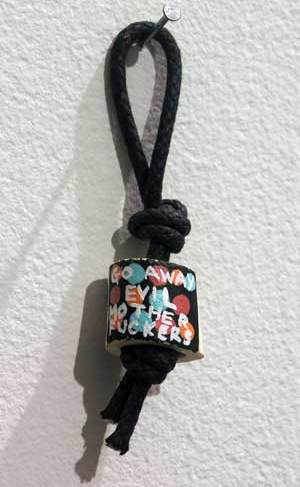 As far as Powhida’s fare, there’s nothing here I haven’t seen before.
As far as Powhida’s fare, there’s nothing here I haven’t seen before.
New target, old hex:
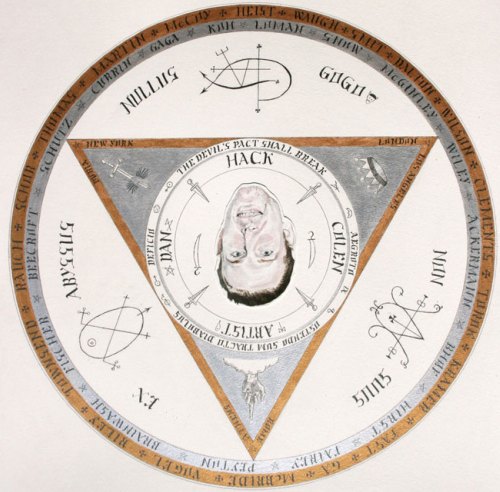 Powhida has an answer for this crass, what-have-you-done-for-me lately critique: (via)
Powhida has an answer for this crass, what-have-you-done-for-me lately critique: (via)
My intention is to critique how the art market consumes people and turns them into commodities to be traded. I’d like to think my work will be remembered because it calls attention to that system, more than cementing the reputations of these artists. You can look back through issues of Artforum and not recognize any of the artists. As Jerry Saltz has said, the art world eats it’s young.
There are a few pieces in the show that work, whether they’re called hexes, exorcisms or art. Congratulations to Letha Wilson for her anti-bombast, pseudo-sublime:
Wilson, Right Back at You
Digital C-print, flashlight, rocks, 42 x 30 x 46 inches, 2009
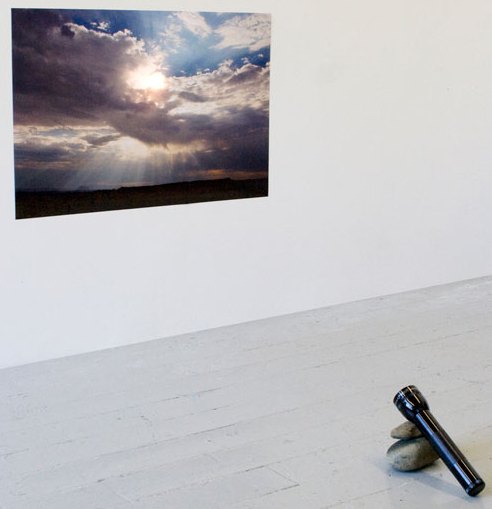 Jade Townsend’s house has a nursery-rhyme appeal: Here is the church, here is the steeple. Open the doors and out come the people (BOOM).
Jade Townsend’s house has a nursery-rhyme appeal: Here is the church, here is the steeple. Open the doors and out come the people (BOOM).
Wilson, Of Alchemy, Dreams and Revolution; Ticking Like A Fucking Bomb Brick
Gold krylon, lauan, wiggle board, ultralite, black bandanas, balsa foam, white latex primer, flat white krylon and paint marker, 16 x 11 x 18 inches, 2007, Courtesy Priska C. Juschka Fine Art
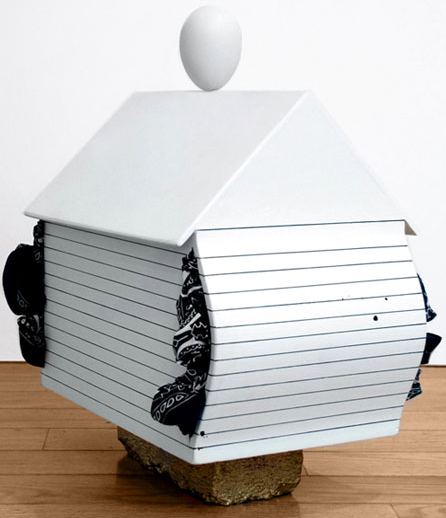 Other surprises? I was surprised that Powhida’s exorcism in chalk was still largely unsmudged on the floor nearly a week after the opening. People tiptoe around it as if it were a sacred thing. Its target is Dale Chihuly’s project at Seattle Center. Note to Powhida: There is such a thing as being a little bit too hip.
Other surprises? I was surprised that Powhida’s exorcism in chalk was still largely unsmudged on the floor nearly a week after the opening. People tiptoe around it as if it were a sacred thing. Its target is Dale Chihuly’s project at Seattle Center. Note to Powhida: There is such a thing as being a little bit too hip.
No one can say the same about Matthew Kangas. Month in and out, he attends nearly every gallery in Seattle and manages to invent fresh ways to insult the dealers. He’s their cross to bear. The rest of us are just too fucking nice.



“Powhida keeps all his crosses on view. He makes art about the art world, mocking its rising stars and pumping his friends.” -Regina Hackett
http://www.seattlepi.com/visualart/378729_inbrief12.html
You put the word conjure in my head a long time ago, and thanks for ignoring the entire portfolio. Did you read any of it? I’m trying to figure out what you are pissed about. Are you still embarrassed you ruined my last performance in Seattle? Are you annoyed we tried to protect the Seattle Center from Chihuly?
Thanks for the thoughtless, passive aggressive review. Letha will be happy and I’m glad you liked something in the show.
-Cheers,
William
William Powhida can dish it out, but he can’t take it.